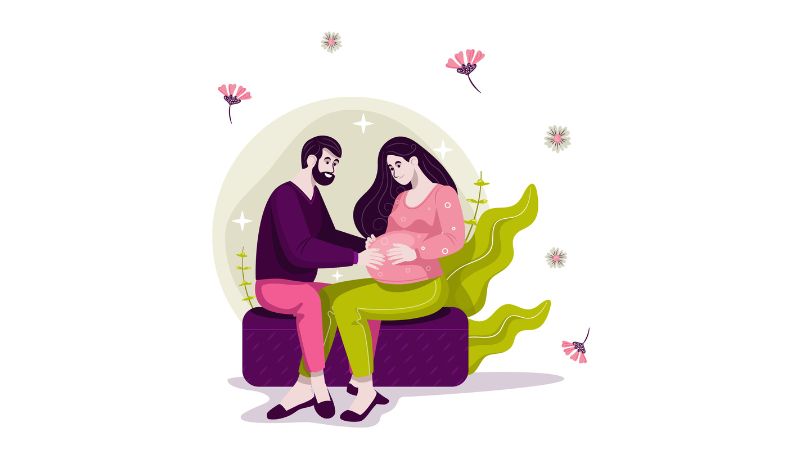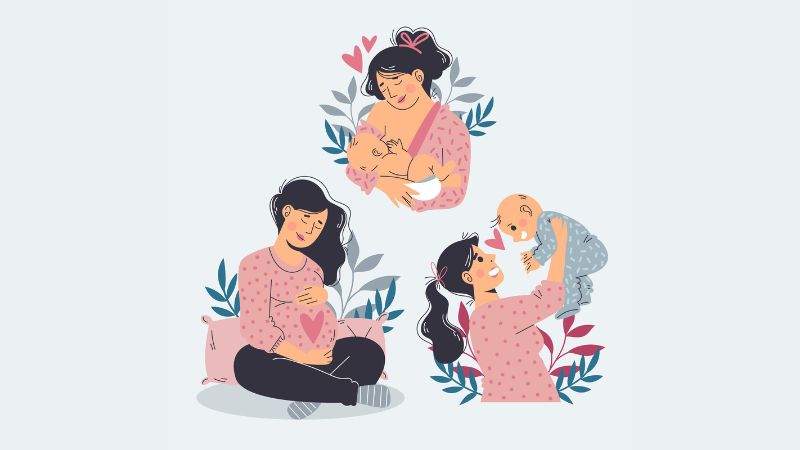Connecting with the baby in the womb, is the baby connected to the mother through the umbilical cord which carries blood vessels. When the mother takes food, it is converted into glucose (energy). Oxygen and glucose are carried to the baby for its growth and development through the umbilical cord. Along with the blood, the mother’s emotions also pass to the baby. The mother’s emotions trigger neurotransmitters/hormones that pass through the blood and trigger the same emotions in the baby.
The baby is directly connected to the mother by design – by structure (umbilical cord) and function. (Feelings are passed through the umbilical cord). This is a unique period in human life where the baby lives under the skin of the mother, two lives living in a single body.
The subconscious mind is dominant for the unborn baby and the analyzing conscious mind is silent during pregnancy; also the bond between the mother and the baby is one of love and joy. Hence the recording (affirmation) in the subconscious mind is easily and effectively done by this mother and the impact of the recording is very powerful and long-lasting like footprints on wet cement; This kind of recording to occur in adults is difficult.
By twenty-eight weeks all five senses are reasonably functional in the womb. Among them, hearing and touch are well-developed. This is proved by scientific studies. So, by touching the mother’s abdomen and talking we can establish a strong bond with the baby.
The baby begins to hear and respond to the sound as early as the 16th week. However, from the 28th week onwards the baby’s responses to sound are so consistent and interactive. As per the results of the findings of the French scientist Alfred Tomatis, the cells of corti in the ear – which absorb sound – exist all over the body in the skin of the fetus. Thus, the entire body functions like a large ear. How amazing is that!

Hearing:
The mother’s heartbeat is the sound the baby hears continuously. This is the nonstop background music in which the baby grows. This is why the baby strikes an immediate relationship with the mother. When the baby is born and starts crying, the mother holds it close to her chest and rests its head on her shoulder; it stops crying because it hears her heartbeat and feels safe and comfortable.
Taste:
Do you know that the baby in your womb can taste as well as smell the food? Some babies retain smell memory and food preferences in the future. According to Deepak Chopra, “Your unborn child is not only nourished by what you eat but may actually be capable of tasting what you taste”.
Smell:
Babies surpass adults in differentiating smells. Several years ago, Aiden Macgarlane conducted a test where he asked nursing mothers to wear gauze pads inside their bras between feeding. He placed a pad on either side of the infant’s head; the baby’s own mother’s pad on one side, and another mother’s on another side. Almost all the infants recognized their mother’s pads by turning toward them. Unbelievably accurate! According to Manella, “It’s possible that in the first few hours after birth, a baby’s sense of smell may be more important in helping him identify his mother than his vision is”. By the age of one week, a baby can pick out her mother’s voice and, at two weeks, can recognize that mother’s voice and, at two weeks, can recognize that the mother’s voice and face belong together (Pre Parenting by Thomas R. Verny, 2002:87)
Touch:
The baby receives continual tactile and kinesthetic stimulation through touch in the womb, the movement of the mother, the amniotic fluid, and the muscular walls of the uterus and Placenta. During pregnancy, the baby responds well through its movements, if the mother’s abdomen is gently stroked, and she gently utters endearing words to the baby. It gives a secure feeling to the baby. After birth, massage therapy helps in keeping the babies awake and active. Newborns placed skin-to-skin with mothers were calm and quiet.
Vision:
A baby’s eyes form early in pregnancy and continue to grow till the baby is two years old. The baby can perceive a bright light shining on the mother’s abdomen; if the light is particularly bright, he will even lift his hands to shield his eyes.
Learning:
‘Our brains are primed for language in the womb’, suggests deCasper’s work. As a result of this natural programming, infants when they are four days old, can distinguish language from other sounds and begin to prefer not just their mother’s voice but also their mother’s language. The fetus undoubtedly experiences the mother’s mental states, such as stress relaxation, sleeping, walking, aerobic exercise, contentment, and anger.
Maternal Stress:
As in everything else, stress plays the spoilsport in the smooth and harmonious journey of pregnancy.
In a study, Curt Sandman and colleagues found a significant connection between prenatal stress and the outcome of a pregnancy, including low birth weight and premature birth. Those with high levels of pregnancy anxiety (about the baby and delivery process), were likely to go for premature birth. It was found that monetary and family problems resulted in low birth weight.
Step 1:
Every day the mother listens to a particular song she likes and enjoys. After a few days, she will notice that the baby moves whenever she listens to the song. Slowly, the mother understands that this movement while listening is not a coincidence, but a regular definite response, indicating that the baby is also enjoying the song. The mother understands that the baby is capable of 1) Listening and enjoying and 2) Expressing its likes through specific responses of prompt, spontaneous, and consistent movements.
Step 2:
Once the mother is sure that the baby is capable of understanding and responding to the song, she becomes confident that the baby will respond to her voice also. She talks to the baby by introducing herself, her husband, and her family members, and tells the baby how much she likes it and how everyone is eager to welcome the arrival. She wants the baby to respond to her talks and waits for respond to her talks and waits for the response; she observes that the baby, (sometimes) slowly, starts responding. She shares her activities with her baby and when the baby responds, the bond becomes stronger. A similar response can be observed on hearing the father’s older child’s or grandparents’ voice.
As more and more mothers started practicing Connecting with the baby in the womb, I observed other benefits. My initial observation was that it was a very good technique to reduce the mother’s anxiety and keep her happy and confident. The other important observation was that the baby’s personality can be shaped through the “soul-seeding” aspect.
Step 3:
“Soul Seeding”: Once the mother-baby bond deepens, the mother specifically talks about skills, achievements, and the qualities the baby should have and the Dos and the DON’Ts. The result is amazing! The mother sees the exact replica of her mental picture in the baby.By practicing this third step the “Soul seeding” personality is developed.

AMAZON: http://surl.li/rxpfl
You can also go through our YouTube channel: ANDAL FERTILITY CHANNEL
We also provide online consultation for long distance patients regarding Pregnancy care and Infertility Problems. Contact +919908854316, 09440278177